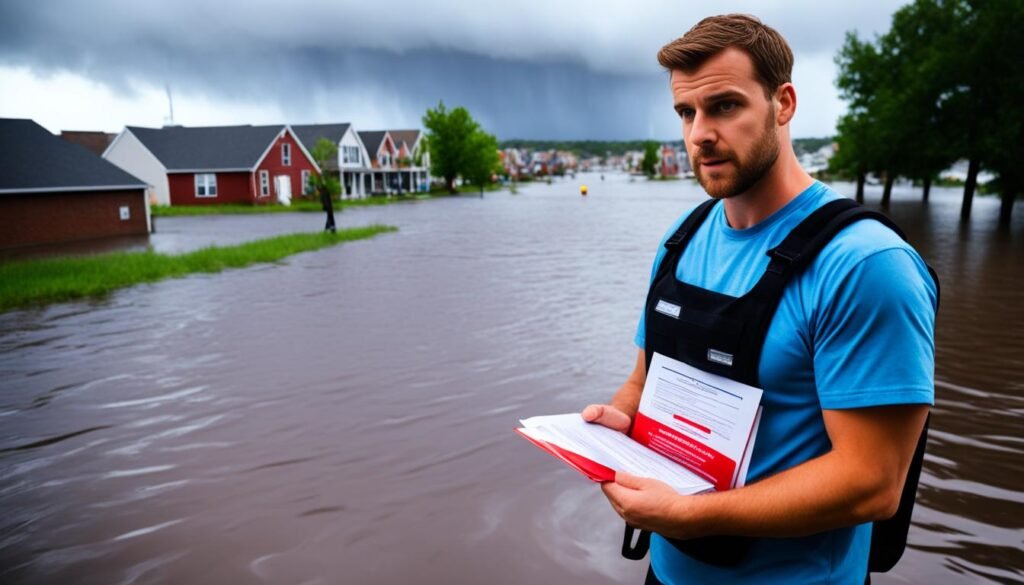Floods are the most common natural disaster in the United States, affecting millions each year.
Having an emergency response guide is critical for your safety in a flood. This guide leads you through emergencies step-by-step. It includes making an incident response plan, crisis management, and training teams. Preparedness is key. By being prepared and knowing what to do, you stay ahead in a flood situation.
Key Takeaways:
- Create an incident response plan and crisis management strategies to handle emergencies effectively.
- Train response teams to ensure seamless coordination during flood situations.
- Emphasize the importance of emergency preparedness and disaster response procedures.
- Follow safety protocols and evacuation instructions from authorities.
- Stay informed about flood risks and sign up for local warning systems.
Preparing for a Flood: Essential Steps to Take
To get ready for a flood, it’s crucial to act early. Knowing the flood risk in your area helps keep you, your loved ones, and your property safe. Here are key steps to follow:
Assess the Flood Risk
Begin by checking your area’s flood risk. Use the Federal Emergency Management Agency’s (FEMA) Flood Map Service Center for info. This helps you prep and plan for emergencies.
Subscribe to a Warning System
Get alerts by signing up for your community’s warning system. Systems like the Emergency Alert System (EAS) and the National Oceanic and Atmospheric Administration (NOAA) Weather Radio are vital. They provide early warnings to keep you and your property safe.
Obtain Flood Insurance
Ensure your home by getting flood insurance. Regular home insurance won’t cover flood damage. Flood insurance is a must for financial safety and recovery after floods.
Plan Evacuation Routes
Know your evacuation routes well. This includes both main and backup paths. Keep an eye on the roads and listen to local authorities to evacuate safely and quickly.
Create Shelter Plans
Be ready to evacuate by making shelter plans. Look for local shelters or safe spots for a temporary stay. Think about your family’s needs, including pets, to have a complete plan.
Secure Emergency Supplies
Build an emergency supply kit as part of your prep. It should have food that won’t spoil, water, meds, first aid kits, flashlights, batteries, and important papers. These supplies are crucial in emergencies.
Take Measures to Protect Your Property
Protect your home from flood damage. Use flood barriers, seal leaks, and raise electric units and appliances. Keep gutters and drains clear to avoid water damage.
Preparing for a flood involves several important steps. Being proactive can lessen the danger to you and your property. Stay informed, have a plan, and care for your safety to successfully manage a flood.
Safety Measures During and After a Flood
Your safety is the most important thing during a flood. If there’s a flood, you must follow evacuation orders right away if told to by the authorities. It’s critical not to underestimate the power of fast-moving water.
Never try to walk, swim, or drive through flood waters. Just six inches of moving water can make you fall, and one foot of water can sweep away a vehicle. It’s always smarter to be cautious.
Avoid bridges if you encounter fast-moving water. Floods can weaken bridges, making them very dangerous. If trapped in a building, go to a higher floor and signal for help when it’s safe. Follow the instructions from the authorities and work with emergency teams.
After the flood, being safe is still crucial. Be careful when going back to your property. Look out for fallen power lines and tell the authorities about them. Always use gloves and boots to clean up debris and get rid of items damaged by the flood.
Be mindful of health risks after a flood too. Mold can grow within a day or two, causing health problems. Take steps to get rid of mold and stop it from spreading. If using generators or other devices, be careful of carbon monoxide in closed spaces. Make sure there’s enough air flow and think about getting carbon monoxide detectors.


